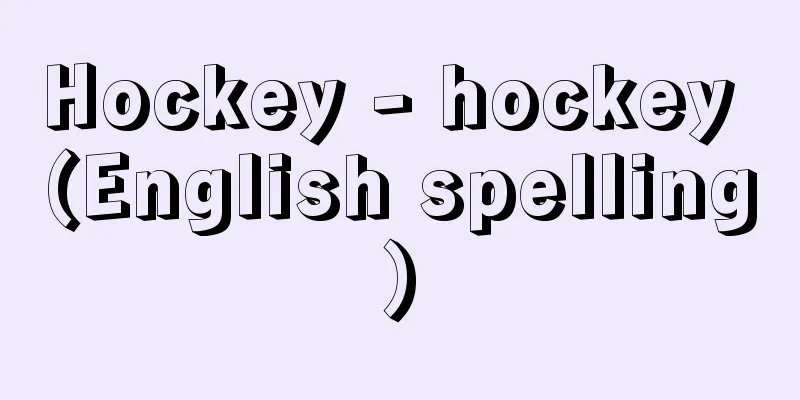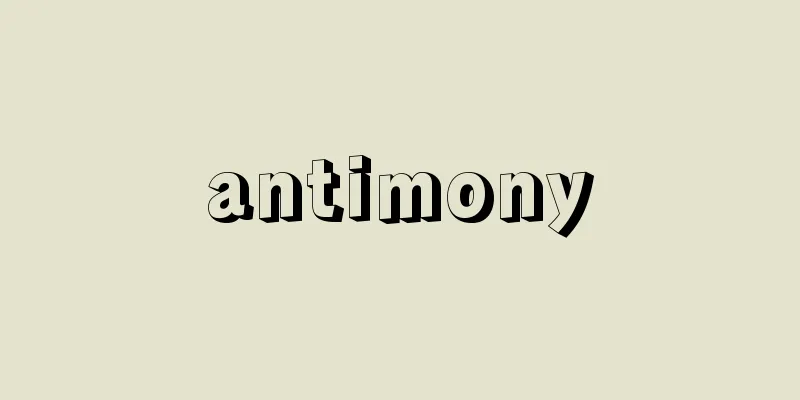Hockey - hockey (English spelling)

|
A type of ball game. It is an official Olympic event in which two teams of 11 players use sticks to dribble or pass the ball and shoot it into the opponent's goal, and the team that scores the most points wins. To distinguish it from ice hockey and roller hockey, it is also called field hockey. [Hideo Ichikawa, Fumio Ogura, and Takayasu Misawa, October 18, 2019] historyGenerally, the birthplace of hockey is said to be England. However, the action of hitting and rolling a ball with a curved stick is rooted in human instincts and has been organized as a game since ancient times, dating back to around 2000 BC. A picture of two people stacking sticks is drawn on the wall of an ancient Egyptian ruin (the Beni Hassan tomb in the Nile basin). In addition, a ruin built in 478 BC (thought to have been a hat factory at the time) discovered in Athens in 1922 has a picture of a bully (the starting action of a game under the old hockey rules), which is thought to be the closest to hockey. After that, through the ancient Greek and Roman eras, as ethnic groups moved and cultural exchanges occurred, hockey is thought to have spread to England and other parts of Europe along with other types of bent stick games (games using curved sticks). Modern hockey was first established in 1886 when the British Hockey Association was founded to standardize the rules of the game. Since then, competitive matches have been played frequently within the UK, but as the country's international development has led to the spread of the sport from Europe to Eastern countries. With the increase in international matches, European hockey organizations, mainly in the UK, founded the International Hockey Federation (FIH = Fédération Internationale de Hockey sur Gazon) in Paris in 1924. Hockey was recognized as an official event at the 3rd Olympic Games in Amsterdam in 1928, and the Olympics helped to spread hockey around the world. Hockey, introduced to India by the British Army's occupation, was enthusiastically received by the Indian people and grew to become the country's national sport. Since the Indian team's first participation and first victory in the Amsterdam Olympic Games, they recorded six consecutive Olympic victories until the 1956 Melbourne Olympics, achieving the feat of going undefeated for 30 years, two years before the Amsterdam Olympics. After the Second World War, Pakistan gained independence from India due to religious conflict, but Pakistan's hockey was on an equal footing with India's, and the two countries became sworn rivals in the Olympics. Other countries that had suffered defeats at the hands of India and Pakistan for 30 years finally found the momentum to fight back, and at the 1968 Mexico Olympics, Australia beat India to come in second (Pakistan won), West Germany won the 1972 Munich Olympics, and New Zealand won the 1976 Montreal Olympics. After artificial turf was adopted for the hockey stadium at the Montreal Olympics, the speed of the game became even faster. As a result, from the late 1980s to the 1990s, European countries and Australia, with their superior speed and power, improved their competitive ability and took the lead in the world hockey world, replacing India and Pakistan. Even after 2000, European countries have continued to lead the world hockey world by establishing a consistent coaching system and advancing tactics. In addition to the Olympics, the Asian Games and World Cup are held in Japan, as well as international junior competitions such as the Junior World Cup and Youth International Championships. Women's hockey is also under the jurisdiction of the International Hockey Federation. It has become increasingly popular in recent years, and was included as an official women's event at the 1980 Moscow Olympics. The stadiums, equipment, and rules are the same as men's hockey, and the sport is played in countries around the world, mainly in Europe and America. As with men's hockey, in addition to the Olympics, there are also Asian Games, Asian Cups, and World Cups. In recent years, indoor hockey using six-player teams has become popular in Europe, and is particularly effective as a winter training program for improving hockey skills, with European championships being held. The rise of European teams is largely due to the adoption of artificial turf as well as the popularity of indoor hockey. [Hideo Ichikawa, Fumio Ogura, Takashi Teramoto, and Takayasu Misawa, October 18, 2019] Japanese HockeyHockey was first introduced to Japan in 1906 (Meiji 39) by the English Reverend William Thomas Grey (1875-1968) of St. Andrew's Church in Azabu, Tokyo, at Keio University. After a period of friendly exchanges with foreign teams in Yokohama and Kobe, the sport was introduced to university teams in the Kanto and Kansai regions, and the Japan Hockey Association (JHA) was founded in 1923 (Taisho 12). The Japanese men's first Olympic appearance was at the 10th Los Angeles Games in 1932 (Showa 7), where the Japanese team won a silver medal. After World War II, Japan began participating in the Rome Games in 1960 (Showa 35), but only managed to come in seventh at the 1964 Tokyo Games. The women's team made their debut at the Athens Games in 2004, and have since competed in four consecutive tournaments: the Beijing Games in 2008, the London Games in 2012, and the Rio de Janeiro Games in 2016. The Asian Games are also held every four years, and great matches are always held between countries such as India, Pakistan, Japan, Malaysia, South Korea, and China. Japan achieved its first victory in both the men's and women's events at the 2018 Jakarta Games. In Japan, the Takamadonomiya Hockey Japan League is at the top for both men and women, and national competitions are held for adults, universities, high schools, junior high schools, and youth sports clubs by age. In addition to strengthening the Japan national team, the government is also promoting measures to strengthen the under-age categories (U16, U18, U21) in an effort to improve competitiveness. [Hideo Ichikawa, Fumio Ogura, Takashi Teramoto, and Takayasu Misawa, October 18, 2019] Competition Method and RulesEach team is made up of 18 players (international and domestic tournaments may have different regulations). A typical team is made up of 3 forwards (FW), 3 midfielders (MF), 2 sidebacks (SB), 2 center backs (CB), and 1 goalkeeper (GK). There are 11 or less players on the pitch, and players can be substituted freely and as many times as they like, so the timing of substitutions greatly affects the game. Various formations are possible depending on the tactics. The game starts with a center pass. The team that wins a coin toss between the captains of both teams has the priority to choose the center pass or the ground side. The rules are mostly set from the perspective of preventing danger to players. Plays that induce danger, such as hitting or hooking the opponent with the stick, are not allowed. Kicking the ball with the foot, stopping or bouncing the ball with the body, and stopping or handling the ball with the back of the stick other than the flat side are also fouls. Offside existed in hockey as well as soccer, but was abolished in 1996 when the rules were revised. This has led to a faster game and more scoring opportunities. All tackles must be made on the ball, and body checks and intentional obstruction of the ball are not permitted. If a foul is committed, play is restarted from the point where the foul was committed by the opposing team with a free hit. If the defending team commits a foul in their own half, especially within the shooting circle (a semicircle with a radius of 14.63 meters in front of the goal), the attacking team is entitled to a penalty corner or penalty stroke depending on the severity of the foul. The goalkeeper is only allowed to kick the ball within the shooting circle. A goal must be scored by an attacking player shooting or touching the ball with their stick within the shooting circle, and a shot from outside the circle does not count as a goal. Therefore, there are no long shots like in soccer, and the highlight of the game is how both the defending and attacking teams compete in front of the goal, using dribbling and passing to tackle each other. In hockey, there are three types of warning and ejection cards: green cards, yellow cards, and red cards. A green card is a warning (2-minute ejection), a yellow card is a 5- or 10-minute ejection, and a red card is an immediate ejection and banishment from the match. There are two umpires, each in charge of one half of the field. The game is played in four quarters of 15 minutes each. There is a 2-minute interval between the first and second quarters and between the third and fourth quarters, and a 10-minute halftime between the second and third quarters. The team that scores more points within that time is declared the winner. If neither team scores or the score is tied, the match is declared a draw. If a winner must be decided, a shootout, similar to a penalty shootout in soccer, is played (as stated above in the FIH and JHA Rules of the Game and the JHA Hockey Rules Commentary). [Hideo Ichikawa, Fumio Ogura, Takashi Teramoto, and Takayasu Misawa, October 18, 2019] Facilities and equipmentAccording to the FIH and JHA rules, a rectangular (artificial turf) ground is used, bounded by a 55-meter backline and a 91.4-meter sideline. The goal measures 2.14 meters high and 3.66 meters wide, with two goal posts (50-75 mm deep) and a crossbar in white. A net is stretched over the goal, with a 0.46-meter-high backboard and sideboards fixed to the bottom of the goal so that they do not extend beyond the width of the goal posts. The stick is made of a material other than metal (carbon, fiberglass, etc.), and only the left side is flat, and the ball can only be handled on this flat surface. There are no sharp edges on the ends. The stick must weigh less than 737 grams overall, and be 105 centimeters long (from the end of the handle to the shortest part of the head), although this varies from person to person. Its width must be wide enough to pass through a ring (a tool for passing the ball) with an inner diameter of 51 mm. The ball weighs 156-163 grams, has a circumference of 224-235 mm, is generally white, and can be made of any material. Currently, most balls are made of plastic. Goalkeepers wear special leg guards, and may also use gloves, headgear, and protective gear. Players generally wear a shirt, shorts, stockings, and shin guards. Women wear a skirt. [Hideo Ichikawa, Fumio Ogura, Takashi Teramoto, and Takayasu Misawa, October 18, 2019] [References] | [Supplementary material] |©Shogakukan "> Hockey Stadium ©Takashi Aoki Hockey stick and ball ©Takashi Aoki Hockey attire and goalkeeper equipment Source: Shogakukan Encyclopedia Nipponica About Encyclopedia Nipponica Information | Legend |
|
球技の一種。オリンピックの正式種目で、11人ずつの2チームがスティックを使って、ボールをドリブルあるいはパスしながら相手ゴールに打ち込み、より多くの得点をしたチームが勝利を得る。アイスホッケーice hockeyや、ローラーホッケーroller hockeyと区別するため、フィールドホッケーfield hockeyともいわれる。 [市川日出男・小倉文雄・三澤孝康 2019年10月18日] 歴史一般にホッケーの母国はイギリスといわれている。しかし、先の曲がったスティックでボールを打ったり転がしたりする動作は、人間の本能的欲求に根ざしていて、古い時代からゲームとして組織化されてきたもので、その起源は紀元前2000年ぐらいにまでさかのぼる。古代エジプト遺跡(ナイル川流域ベニ・ハッサン墳墓)の壁に、2人の人物がスティックを重ねている図が描かれている。また1922年アテネで発見された紀元前478年に建てられた遺跡(当時の帽子工場と思われる)には、ブリーbully(ホッケーの旧ルールの試合開始動作)の絵が残されており、これがもっともホッケーに近いものと思われる。その後古代ギリシア・ローマ時代を経て、民族の移動と文化交流につれ、他種のベンド・スティック・ゲーム(先の曲がったスティックを使うゲーム)などとともに、イギリスやヨーロッパ各地に伝えられたと思われる。 近代ホッケーは1886年、競技ルール統一のためイギリスにホッケー協会が設立されて初めて確立された。以後イギリス国内で盛んに対抗試合が行われる一方、同国の国際的発展につれて、ヨーロッパ各国から東方諸国にまで普及していった。イギリスを中心とするヨーロッパのホッケー団体は、国際試合の増加に伴い、1924年パリに国際ホッケー連盟(FIH=Fédération Internationale de Hockey sur Gazon)を創立。1928年第3回オリンピック・アムステルダム大会から正式種目として認定され、オリンピックがホッケーを世界に広めることとなった。 イギリス陸軍の進駐によってインドに伝えられたホッケーは、インド国民に熱狂的に迎えられ、同国の国技となるまでに成長を遂げた。インドチームはオリンピック・アムステルダム大会に初参加、初優勝して以来、1956年メルボルン大会までオリンピック6連覇を記録し、アムステルダム大会の2年前から30年間無敗という偉業を達成した。第二次世界大戦後に宗教上の対立からパキスタンがインドから独立したが、パキスタンのホッケーはインドと対等の戦力をもち、両国はオリンピックの宿命的ライバルとなった。30年間にわたってインド、パキスタンに敗北を喫してきたその他の諸国も、ようやく反撃の機運にのり、1968年オリンピック・メキシコ大会では、オーストラリアがインドを押さえて2位に進出(パキスタン優勝)、1972年ミュンヘン大会は西ドイツ、1976年モントリオール大会はニュージーランドがそれぞれ優勝した。このモントリオール大会でホッケー競技場に人工芝が採用されてからは、競技のスピード化がいっそう進んだ。その結果、1980年代後半から1990年代にかけては、スピード、パワーに優れたヨーロッパ諸国やオーストラリアがインド、パキスタンにかわって競技力を向上させ、世界のホッケー界をリードした。2000年以降も、ヨーロッパ諸国は一貫指導体制の整備、戦術の高度化を進めることで世界のホッケー界をリードし続けている。オリンピックのほかにアジア大会、ワールドカップなどが開催され、ジュニアワールドカップ、ユース国際大会などのジュニア層の国際大会も開催されている。 女子ホッケーも、国際ホッケー連盟の統括下にある。近年その普及ぶりは目覚ましく、オリンピックには1980年のモスクワ大会から女子競技の正式種目として登場した。競技場、用具、ルールなどは男子ホッケーと同様で、ヨーロッパ、アメリカを中心に世界各国で行われている。男子と同じく、オリンピックのほかに、アジア大会、アジアカップ、ワールドカップなどが開催されている。 近年ヨーロッパでは6人制によるインドア・ホッケーが盛んになり、とくに冬季練習としてもホッケー技術の向上に効果を発揮し、ヨーロッパ選手権も行われている。ヨーロッパ勢の台頭は、人工芝の採用に加えてインドア・ホッケー普及の寄与するところが大きい。 [市川日出男・小倉文雄・寺本 崇・三澤孝康 2019年10月18日] 日本のホッケー日本にホッケーが伝わったのは、1906年(明治39)東京・麻布(あざぶ)の聖アンドリュース(アンデレ)教会のイギリス人牧師グレーWilliam Thomas Grey(1875―1968)の手で慶応義塾大学に紹介されたのが初めである。その後、横浜、神戸の外国人チームとの親善交流期を経て、関東、関西の各大学チームに伝えられ、1923年(大正12)には日本ホッケー協会(JHA:Japan Hockey Association)が創立されている。男子のオリンピックへの初出場は1932年(昭和7)第10回ロサンゼルス大会で、日本チームは銀メダルを獲得した。第二次世界大戦後は、1960年(昭和35)ローマ大会から参加し、1964年東京大会では第7位にとどまった。女子については、2004年(平成16)アテネ大会に初出場し、その後2008年北京大会、2012年ロンドン大会、2016年リオ・デ・ジャネイロ大会と、4大会連続で出場している。アジア大会も4年ごとに開催されており、インド、パキスタン、日本、マレーシア、韓国、中国などの間で毎回好試合が展開されている。日本は2018年ジャカルタ大会において、男女ともに初優勝を達成した。 日本国内では、男女ともに高円宮牌(たかまどのみやはい)ホッケー日本リーグを頂点とし、社会人、大学、高等学校、中学校、スポーツ少年団と年齢別に国内競技会を開催している。日本代表の強化に加えアンダーエイジカテゴリー(U16、U18、U21)の強化策を推進し、競技力の向上が図られている。 [市川日出男・小倉文雄・寺本 崇・三澤孝康 2019年10月18日] 競技方法とルール1チームは18人編成(国際、国内の大会ともに別規定で行われる場合もある)。一般的なチームの編成は、フォワードFW3人、ミッドフィルダーMF3人、サイドバックSB2人、センターバックCB2人、ゴールキーパーGK1人で、ピッチ内には11名以下、選手交代は自由で、なおかつ何回でも交代できるので、選手交代のタイミングが試合を大きく左右する。戦術に応じて種々の編成が考えられる。ゲームはセンターパスで開始される。両チームの主将によるコイントスに勝った側が、センターパスあるいはグラウンド・サイドの選択についての優先権をもつ。ルールはおおむねプレーヤーの危険防止の見地から定められている。スティックで相手をたたいたりひっかけたりすることなど、危険を誘発するプレーは許されない。ボールを足で蹴ったり体で止めたり跳ね上げたりすること、スティックの平面以外の裏側でボールを止めたり扱ったりすることも反則である。オフサイドは、サッカー同様ホッケーにも存在していたが、1996年ルール改正により廃止された。それにより試合展開が加速し得点機会の増加につながった。タックルはすべてボールに対してのみ行われなければならず、ボールを持つプレーヤーに対するボディーチェックや故意の走路妨害(オブストラクション)は許されない。反則を犯した場合は、その地点から相手側のフリーヒットによりプレーを再開する。守備側が自陣内とくにシューティング・サークル(ゴール前の半径14.63メートルの半円)内において反則を犯した場合は、その程度に応じて、攻撃側に対してペナルティ・コーナーまたはペナルティ・ストロークの権利が与えられる。ゴールキーパーは、シューティング・サークル内に限りボールを蹴ることが許される。得点は、シューティング・サークル内で、攻撃側プレーヤーが、シュートあるいはスティックで触れたものでなければならず、サークル外からのシュートは得点とはならない。したがって、サッカーのようなロングシュートはなく、守備・攻撃側ともゴール前での競り合いで、お互いドリブル、パスを使ってどう立ち向かうかがゲームとしての見所である。 ホッケーでは、警告・退場のカード、すなわちグリーンカード、イエローカード、レッドカードの3種類がある。グリーンカードは警告(2分間の退場)、イエローカードは5分または10分間の退場で、レッドカードは即時退場、その試合には出場不可となる。アンパイアは2人、それぞれグラウンドの半面を担当する。試合時間は各15分の4クォーターで行われる。第1と第2クォーター、および第3と第4クォーターの間には2分のインターバル、第2と第3クォーターの間には10分間のハーフタイムを設ける。時間内に、より多く得点したチームが勝者となる。両チームとも無得点または同点の場合は、その試合は引き分けとする。勝敗を決めなければならない場合は、サッカーのPK戦にあたるシュート・アウト戦が行われる(以上、FIHおよびJHAの競技規則、JHAホッケールール解説による)。 [市川日出男・小倉文雄・寺本 崇・三澤孝康 2019年10月18日] 施設と用具FIHおよびJHAの競技規則によれば、55メートルのバックライン、91.4メートルのサイドラインで仕切られた長方形(人工芝)のグラウンドを使用する。ゴールの大きさは高さ2.14メートル、幅3.66メートルで、2本のゴールポスト(奥行50~75ミリメートル)とクロスバーは白色とする。ゴールを覆ってネットを張るが、ゴールの下部には高さ0.46メートルのバックボード、サイドボードがゴールポストの幅よりはみ出さないように固定されている。スティックは金属以外の材質(カーボン、グラスファイバーなど)で、左側のみ平面になっていて、この平らな面でしかボールを扱えない。末端各部には角をつけない。スティックは、個人差はあるが全体の重さは737グラム以下、長さ(ハンドル部分の端からヘッドの最短部まで)は105センチメートル以下のものを使用する。その幅は、内径51ミリメートルのリング(リングパスのための用具)を通過する幅でなければならない。ボールは重量156~163グラム、周径224~235ミリメートルで、白色のものが一般的、材質は問わない。現在は主としてプラスチック製のものが使われている。ゴールキーパーは特製のレガード(すね当て)を使用し、またグローブ、ヘッドギア、プロテクターを用いることができる。プレーヤーの服装は、一般的にはシャツ、ショートパンツ、ストッキング、すね当てを使用する。女子の場合にはスカートを着用する。 [市川日出男・小倉文雄・寺本 崇・三澤孝康 2019年10月18日] [参照項目] | [補完資料] |©Shogakukan"> ホッケーの競技場 ©青木 隆"> ホッケーのスティックとボール ©青木 隆"> ホッケーの服装とゴールキーパーの用具 出典 小学館 日本大百科全書(ニッポニカ)日本大百科全書(ニッポニカ)について 情報 | 凡例 |
Recommend
Akahada Kiln - Akahadayo
...Seven kilns that are said to have been taught ...
Lord Okinaga Yamada - Lord Okinaga Yamada
...There is also a strong theory that they were i...
Ganshikakun - Family Precepts of the Gan Family
This book is a set of 20 chapters in 2 volumes, w...
Nakamura [city] - Nakamura
An old city in the southwest of Kochi Prefecture. ...
Aspirin - Aspirin (English spelling)
A typical non-pyrine antipyretic analgesic also k...
Tanezu - Kusatsu
… [Shozo Ido] [Kusatsu Post Town] A post station ...
Koriyama Domain
A domain that ruled the area around Koriyama, Sou...
Juhász G.
…The most representative figure was Adi, whose li...
Country song - Inakauta
〘noun〙① A folk song sung in the countryside. Hinau...
Abudefduf sordidus (English spelling) Abudefduf sordidus
… [Makoto Shimizu]. . … *Some of the terminology ...
Erythrodextrin - Erythrodextrin
…These are collectively called dextrins. Among th...
Account executive
Usually referred to as an AE, this is a unique job...
Regent - Sessho
An important position that governs the country on...
Ahdas - Ahdas
… [Ryosho Hayashi] [Islamic World] A group of chi...
Snowdon
British politician. Known as a Labour Party expert...









